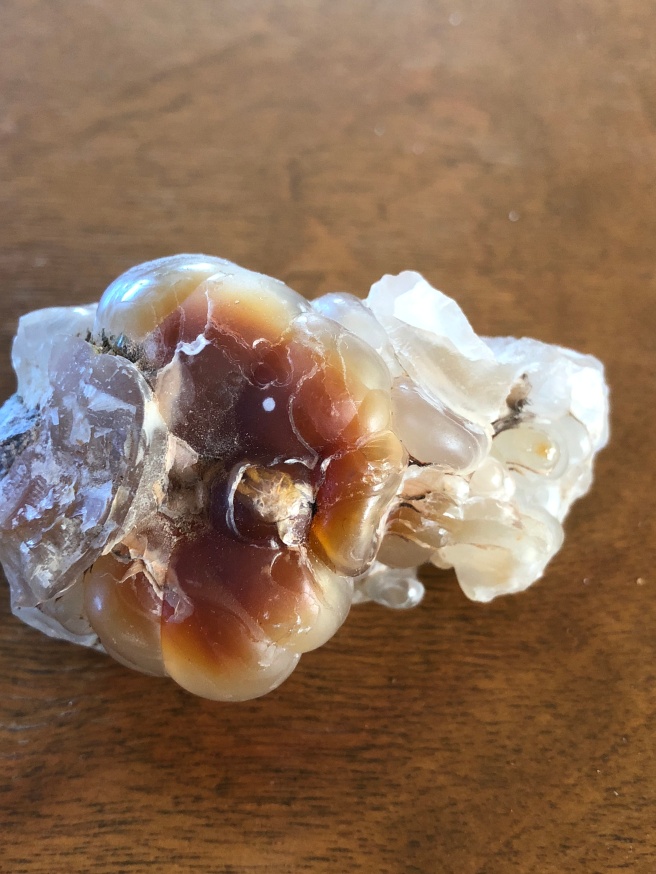Ken and I have become quite interested in Fire agates after finding them at Saddle mountain and near Oatman, Arizona. One might say we have become obsessed……
I should note here that we did not find our treasures in precisely the place the book outlined that we would. Perhaps we were….. thinking outside the box. Turning left instead of right, on one side of the road instead of the other….
It has been hard to envision how the rough form of Fire agate becomes the gems seen in many booths at quartzsite.
rough one of mine… thin layers will need to be removed.

rough of mine

gems at quartzsite

Just google ” fire agates” to see much better photos of them. I HAVE tried stealing pictures off the internet, but am not computer savvy enough to figure out how to do it.
What we have discovered is that there is a little more work involved in getting the rough stone down to the fire agate gem.
The following is an excerpt from an article by Edgar B. Heylmun, PhD 2002 (of course I HAVE corrected his spelling of the word colour) 🙂
“Agate nodules are created when silica, in solution, enters and slowly fills a gas cavity in volcanic rocks. Agate and volcanic rocks have more porosity and permeability than what meets the eye, and layer upon layer of silica is deposited in the cavity until it is filled. Agate may also be deposited in seams and fractures in volcanic rocks. The mineralized solutions were probably formed during the cooling of the volcanic rocks, though considerable silica could be deposited over the years by cold circulating ground water. The porosity of agate is demonstrated by the ease in which agate can be artifically coloured.
Fire agate is a challenge to cut and polish in such a way as to preserve the fire, so it is popular with lapidary artists. The fire is caused by a thin layer of iridescent iron oxide that was deposited in a botryoidal (bubbly) manner. The bubbly nature of the layer was probably caused by small gas bubbles that were later filled with silica and water. It is imperative that the layer of silica covering the iron oxide be clear. Otherwise, the fire would not be discovered. When grinding, a lot of delicate work is required, aided by microscopic examination. There may be several thin layers of iron oxide, each with fire of a different colour, so it is quite a challenge to cut and polish such material en cabochon. The principal flashes of fire are golden yellow to green, but some valuable specimens exhibit a brilliant red. Sometimes, fire is evident in specimens before any cutting is done. The iron oxide is hydrous, so water in the thin layer adds to the fire, as does water in inter-layered silica which may, in fact, be fire opal. One of the lapidary rules is to wet grind fire agate, not saw it.”
There is a “fire” that exists deep in the stone that you must grind/Dremel….. your way into without destroying the stone within. You must use diamond blades and Dremel tools …. but bearing in mind that diamonds are harder than agates, so if you go too far you destroy the “fire agate”.
This is one that I have found that has very little chalcedony covering the fire. I guess it was with this one that we began to understand the process.

I am thinking the process will be great fun, sort of like cleaning the garlic, you peel away the outside layers of the garlic to reveal the colours within. I LOVE that part of being a garlic grower.
… and flowers on the cactus…

Tucker pretending to be a coyote.

and Mr RV repairman KEN…. Kitchen sink was leaking yesterday, now we need to get a new drain. Piece by piece we are buying ourself a brand new RV…….. 🙂

I have struggled writing this Blog, because I did it 2 days ago, and went to post it and it disappeared Hard to write the same thing twice.
MUCH love to all
Janet